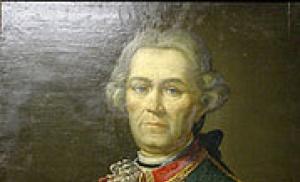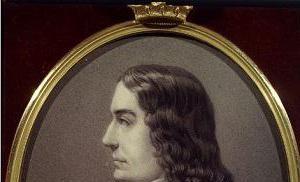Meters, feet and sizes. Dimensions in versification: iambic tetrameter
SIZE POEM- a method of organizing the sound composition of a separate poetic work or its excerpt (in the case of polymetry). In syllabic versification it is determined by the number of syllables; in tonic number of stresses; in metric and syllabic-tonic meter and the number of feet, and here the concepts of meter (for example, “iamb”), poetic meter (for example, “iambic 4-foot”) and a variety of poetic meter (for example, “4- iambic foot with solid male endings"). METER in verse - an orderly alternation in verse of strong places (ikts) and weak places, filled in different ways. Thus, in a syllabic-tonic anapest, strong places occur on every 3rd syllable and are filled exclusively with stressed syllables (the stress here is a “constant”), and weak places are on intermediate syllables and are filled primarily with unstressed syllables (unstressed here is the “dominant”). Meter in this meaning of the word is present in metric, syllabic-tonic, melodic versification and absent in syllabic and tonic. FOOT- a repeating combination of a strong and weak place in poetic meter, serving as a unit of verse length (for example, 2-, 3-, 4-foot poetic meters). JAMB- (Greek iambos), poetic meter with strong places on the even syllables of the verse (“My uncle has the most honest rules...”, A.S. Pushkin). The most common of the meters of Russian syllabic-tonic verse; main sizes 4-foot (lyrics, epic), 6-foot (poems and dramas of the 18th century), 5-foot (lyrics and dramas of the 19-20th centuries), free multi-foot (fable of the 18th-19th centuries, comedy of the 19th century .). HOREUS- (Greek choreios, lit. dancing), trochei (Greek trochaios, lit. running), poetic meter with strong places on the odd syllables of the verse (“I disappeared like an animal in a pen,” B.L. Pasternak). The most common sizes of the Russian syllabic-tonic chorea are 4-, 6-foot, with ser. 19th century 5-foot. DACTYL- (Greek daktylos, lit. finger), poetic meter formed by 3-syllable feet with strong point on the 1st syllable of the foot (“A deep hole is dug with a spade”, I.S. Nikitin). The most common sizes of the Russian syllabic-tonic dactyl. Dactyl 2-foot (in the 18th century), 4- and 3-foot (in the 19th-20th centuries). AMPHIBRACHIUS- (Greek amphibrachys, lit. short on both sides), poetic meter formed by 3-syllable feet with a strong place on the 2nd syllable (“It is not the wind that rages over the forest”). The most common sizes of the Russian syllabic-tonic amphibrachium are 4-foot (from the beginning of the 19th century) and 3-foot (from the mid-19th century). ANAPAEST- (from the Greek anapaistos, reverse dactyl, lit. reflected back), poetic meter formed by 3-syllable feet (see foot), with a strong place on the 3rd syllable; on the initial syllable of the line there is often a super-schema stress (“There, in the howling cold of the night,” A.A. Blok). The most commonly used sizes of the Russian syllabic-tonic anapest are 4- and 3-foot (since the mid-19th century).
Trochee
Trochee- a two-syllable foot with stress on the first syllable (trochaic foot pattern: ! -), and in the line (verse) as a whole - on the first, third, fifth, seventh, etc. (It should be remembered that stress omissions on individual syllables and the formation of stops are possible pyrrhic)
The clouds are melting in the sky,
And, radiant in the heat,
The river rolls in sparks,
Like a steel mirror.
! - ! - ! - !
! - ! - ! - ! -
! - ! - ! - !
! - ! - ! - ! –
The golden cloud spent the night
On the chest of a giant rock;
In the morning she rushed off early,
Having fun playing across the azure...
! - ! - ! - ! - ! -
! - ! - ! - ! - ! -
! - ! - ! - ! - ! -
! - ! - ! - ! - ! –
Trochee- (Greek choreios, lit. dancing), trochei (Greek trochaios, lit. running), poetic meter with strong places on the odd syllables of the verse (“I disappeared like an animal in a pen,” B.L. Pasternak). The most common sizes of the Russian syllabic-tonic chorea are 4-, 6-foot, with ser. 19th century 5-foot.
Iambic- a two-syllable foot with stress on the second syllable (iambic foot pattern: -!), and in the verse as a whole - on the second, fourth, sixth, eighth, tenth, etc.
Again I stand over the Neva,
And again, like in years past,
I look, as if alive,
To these slumbering waters
- ! - ! - ! - !
- ! - ! - ! - ! -
- ! - ! - ! - !
- ! - ! - ! - ! -
Here is a wooded hill, above which
I sat motionless and looked
To the lake, remembering with sadness
Other shores, other waves...
- ! - ! - ! - ! - ! -
- ! - ! - ! - ! - !
- ! - ! - ! - ! - ! -
- ! - ! - ! - ! - ! -
Iambic- (Greek iambos), poetic meter with strong places on the even syllables of the verse (“My uncle has the most honest rules...”, A.S. Pushkin). The most common of the meters of Russian syllabic-tonic verse; main sizes 4-foot (lyrics, epic), 6-foot (poems and dramas of the 18th century), 5-foot (lyrics and dramas of the 19-20th centuries), free multi-foot (fable of the 18th-19th centuries, comedy of the 19th century .).
Poetic size- this is a certain order in which stressed and unstressed syllables are placed in the foot.
Foot is a unit of verse length; repeated combination of stressed and unstressed syllables; a group of syllables, one of which is stressed.
Example:
The storm covers the sky with darkness
1) Here, after a stressed syllable, one unstressed syllable follows - a total of two syllables. That is, it is a two-syllable meter. A stressed syllable can be followed by two unstressed syllables - then this is a three-syllable meter.
2) There are four groups of stressed-unstressed syllables in the line. That is, it has four feet.
SINGLE SIZE
Brachycolon- monocotyledonous poetic meter. In other words, a verse consisting of only stressed syllables.
Example of brachycolon:
(V. Khodasevich)
DOUBLE SIZES
Trochee
A two-syllable poetic foot with stress on the first syllable.
That is, the first, third, fifth, etc. syllables are stressed in a line.
Main dimensions:
4-foot
6-foot
5-foot
An example of a trochaic tetrameter:
The storm covers the sky with darkness ∩́ __ / ∩́ __ /∩́ __ / ∩́ __
Whirling snow whirlwinds; ∩́ __ / ∩́ __ / ∩ __ / ∩́
(A.S. Pushkin)
Iambic
A two-syllable poetic foot with stress on the second syllable.
That is, the second, fourth, sixth, etc. syllables are stressed in a line.
A stressed syllable can be replaced by a pseudo-stressed one (with secondary stress in the word). Then the stressed syllables are separated not by one, but by three unstressed syllables.
Main dimensions:
4-foot (lyrics, epic),
6-foot (poems and dramas of the 18th century),
5-foot (lyrics and dramas of the 19th-20th centuries),
Free Raznostopny (fable 18-19 centuries, comedy 19 centuries)
Example of iambic tetrameter:
My uncle of the most honest rules, __ ∩́ / __ ∩́ / __ ∩́ / __ ∩́ / __
When seriously ill, __ ∩́ / __ ∩́ / __ ∩ / __ ∩́ /
He made __ ∩ / __ ∩́ / __ ∩́ / __ ∩́ / __ respect himself
And I couldn’t imagine anything better. __ ∩́ / __ ∩́ / __ ∩ / __ ∩́ /
(A.S. Pushkin)
An example of iambic pentameter (with pseudo-stressed syllables, they are highlighted in capital letters):
We are dressed up to explore the city together, __ ∩́ / __ ∩ / __ ∩́ / __ ∩́ / __ ∩́ / __
But it seems we have no one to look after... __ ∩́ / __ ∩ / __ ∩́ / __ ∩ / __ ∩́
(A.S. Pushkin)
TRIPLE SIZES
Dactyl
A three-syllable poetic foot with stress on the first syllable.
Main dimensions:
2-foot (in the 18th century)
4-foot (since the 19th century)
3-foot (since the 19th century)
Example:
That glasses are not be sleepy, ve personal countries nicks! ∩́ __ __ /∩́ __ __ / ∩́ __ __ / ∩́ __ __ /
St e I drink laz y rnoyu, ts e I drink pearls y reaping... ∩́ __ __ /∩́ __ __ / ∩́ __ __ / ∩́ __ __ /
(M.Yu. Lermontov)
Amphibrachium
A three-syllable poetic foot with stress on the second syllable.
Main dimensions:
4-foot ( early XIX V.)
Example:
Not ve ter boo shu it's over bo rum, __ ∩́ __ / __ ∩́ __ / __ ∩́ __ /
Not with mountains pobe zha Lee Ru whose - __ ∩́ __ / __ ∩́ __ / __ ∩́ /
Mo roses-howl in yes to zo rum __ ∩́ __ / __ ∩́ __ / __ ∩́ __ /
About xo dit vla de Nya svo And. __ ∩́ __ / __ ∩́ __ / __ ∩́ /
(N.A.Nekrasov)
Anapaest
A three-syllable poetic foot with stress on the last syllable.
Main dimensions:
4-foot (from the middle of the 19th century)
3-foot (from the middle of the 19th century)
Example of a 3-foot anapest:
Oh the weight on no con tsa and without edge yu - __ __ ∩́ / __ __ ∩́ / __ __ ∩́ / __
No con tsa and without edge yu sword that
Find out Yu you, life! Priny ma Yu! __ __ ∩́ / __ __ ∩́ / __ __ ∩́ / __
And when vets yours call nom cabbage soup that! __ __ ∩́ / __ __ ∩́ / __ __ ∩́ /
(A. Blok)
How to remember the features of two- and three-syllable meters?
You can remember it with this phrase:
Dombai is walking! Lady, lock the gate in the evening!
(Dombay is not only a mountain; translated from some Caucasian languages it means “lion”).
Now let's move on to three-syllable feet.
The word LADY is formed from the first letters of the names of three-syllable feet:
D– dactyl
AM– amphibrachium
A– anapest
And in the same order, the following words of the sentence belong to these letters:
D actil | In the word DAMA, the letter D means dactyl. The word EVENING has three syllables, the stress is on the first syllable. Thus, a three-syllable meter with stress on the first syllable is a dactyl. |
|
AM fibrachium | In the word DAMA, the letters AM stand for amphibrachium. The word KALITKU has three syllables, the stress is on the second syllable. Thus, a three-syllable meter with stress on the second syllable is an amphibrach. |
|
A nastiness | In the word DAMA, the last letter A means anapest. The third word (LOCK) has three syllables, the stress is on the third syllable. Thus, a three-syllable meter with stress on the third syllable is an anapest. |
You can still imagine it this way.
Dear guests and newcomers, welcome to our forum
Here you can find answers to almost all your questions about the Gothic series of games (including various mods for it), The Witcher, Risen, The Elder Scrolls, Age of the Dragon and many other games. You may also want to know latest news about developing new projects, playing exciting FRPGs, admiring the creativity of our forum members, or showing yourself what you can do. And finally, you can discuss common hobbies or just have fun chatting with visitors to the Tavern.
To be able to write on the forum, leave a message at
Attention!
- Requires approximately 3-5 people for each OS version: - Windows® XP SP3, Windows® Vista SP2, Windows® 7 SP1, Windows® 8, Windows® 8.1, Windows® 10 (build 10 1607) and Windows® 10(build 10 1703). For desktop PCs and laptops. You can submit your application for participation
JavaScript is disabled. To fully experience our site, please enable JavaScript in your browser.
Status New replies cannot be posted in this topic.
16 Jul 2007
Good afternoon. Let's start with...
But first, a few words: Many will say that he does not need this information, that he writes as he wants, etc. It’s your choice, I don’t encourage you to memorize this text as a truism... Write poetry as you want, even backwards... BUT (!) you need to understand that you won’t go far without theory. Let me give you an example: can you build a house without knowing the basics of construction? Of course you can! But this house will collapse from the blowing wind... at most you will get either a kennel or a hut... also not bad, but not a fountain. If you don’t understand, I’ll give you example number two - you can make a pie without knowing how and from what? Of course you can!! Just so as not to poison all your friends and relatives... The same principle applies here! You may not cook according to the suggested recipe, but knowing where each component is is very desirable! I think so! (With)
First, a little general knowledge. 8)
Versification and Poetry
Versification systems:
1. Metric (quantitative)– characteristic of antiquity: ancient Greek and Latin languages. Based on counting the length/shortness of vowel sounds. It is based on the concept of meter. The alternation of words with long and short sounds set the rhythm of the verses, which were sung to the accompaniment of a lyre or cithara. Ancient poetry was inseparable from music; accordingly, poetic speech was inextricably linked with song speech. There was no rhyme. The concept of meter was borrowed from Russian versification.
2. Syllabic – "syllabic". Based on an equal number of syllables in a verse. Characteristic of languages with constant, fixed stress - Turkic, Romance (French, Spanish, Italian), Slavic (Serbo-Croatian, Polish, Czech) and others. For example, in French stress on the last syllable of the word, Polish (second syllable from the end), Czech (third syllable from the end). It was used in Russian poetry from the mid-17th century to the 30s of the 18th century; the main sizes are 8-, 11- and 13-syllable. The very concept of “syllabic versification” was introduced by the largest Russian poet of the second half of the 17th century, the scholar-monk Simeon of Polotsk, close to the royal court. Only the number of syllables was important, so the stress was often placed offset from the usual position in the word. Syllabic versification in Rus' was abolished by the Trediakovsky-Lomonosov reform.
3. Tonic – "tonos" - "emphasis". The basic principle is equal stress, that is, an equal number of stresses in a verse (line). However, there may be deviations from this principle, since this system is typical for languages with strong movable stress (English, German, Russian).
4. Syllabic-tonic. Its main principle is the natural and orderly alternation of stressed and unstressed syllables (the stress plays decisive role). Syllabic-tonic versification was introduced in Rus' by Trediakovsky and Lomonosov, replacing syllabic versification.
Main sections of poetry:
I. Metrics and rhythm.
Metrics- a section of poetry about the combination of strong and weak points in a verse, about the metric structure of a line, about systems of versification, about poetic meters and meters.
Rhythmics- a section of poetry that studies, together with metrics, the laws of the structure of a poetic line, its rhythmic variations, regular repetitions of verbal and sound material (syllables, words, periods, verses, phrases, stanzas, etc.). They also talk about the rhythm of the poems of a particular poet, style, era.
II. Phonics(euphony) is an area of versification that studies the sound organization of poetic speech.
III. Melodica- an area that studies the system of distribution of rising and falling intonations in poetry.
IV. Strophic- a section of poetry that studies the forms of combining poems into a compositionally complete whole; the doctrine of an ordered combination of poetic lines that are naturally repeated in a text.
V. The doctrine of rhyme.
METRICS AND RHYTHMICS
Rhythm- sound structure of a specific poetic line (verse); general orderliness of the sound structure of poetic speech. A special case of rhythm is meter.
Meter- orderly alternation of stressed and unstressed syllables in verse, general scheme sound rhythm.
Size– method of sound organization of verse; a special case of the meter. For example, iambic meter can include meters from 1-meter to 12-meter (or more) iambic, as well as free iambic. In syllabic versification, meter is determined by the number of syllables; in tonic - by the number of stresses; in metric and syllabic-tonic - by meter and number of feet.
The syllabic-tonic system of versification adopted basic meters, named by analogy with ancient meters: trochee, iambic, dactyl, amphibrachium, anapest.
16 Jul 2007
Now in more detail...
Poem- a separate line, ordered (if the meter is iambic in the first line, then usually the second line is too) and repeating.
Foot– a repeated combination of stressed and unstressed syllables (strong and weak points), a unit of verse length.
Legend:
1 - stressed syllable
0 - unstressed syllable
/ - indicator of the end of the foot, separates one foot from the other.
Two-syllable sizes:
Trochee- (scheme: 1 0, that is, stressed + unstressed syllables) stress in the line as a whole - on the first, third, fifth, seventh, etc. syllable.
The tu-chi are rushing, the tu-chi are curling,
1 0 / 1 0 / 1 0 / 1 0
We don't see Lu-na
0 0 / 1 0 / 0 0 / 1
Oh, the flying snow is shining;
0 0 / 1 0 / 1 0 / 1 0
It's muddy, but the night is muddy.
1 0 / 1 0 / 1 0 / 1
(A. Pushkin)
There's a cloud in the sky,
1 0 / 1 0 / 1 0 / 1
And, lu-chis-ta-ya in the heat,
1 0 / 1 0 / 1 0 / 1 0
In the sparks the river flows,
1 0 / 1 0 / 1 0 / 1
It’s like a mirror of steel.
1 0 / 1 0 / 1 0 / 1 0
Iambic– (scheme: 0 1, that is, unstressed + stressed syllables) stress in the line is on the second, fourth, sixth, eighth, tenth, etc. syllable. Main sizes: 4-foot (lyrics, epic), 6-foot (poems and dramas of the 18th century), 5-foot (lyrics and dramas of the 19-20th centuries), free multi-foot (fable of the 18th-19th centuries, comedy of the 19th) V.).
O-five hundred I am above the Ne-voy,
0 1 / 0 1 / 0 1 / 0 1
And again, just like in the old days,
0 1 / 0 1 / 0 1 / 0 1 / 0
I look, too, as if alive,
0 1 / 0 1 / 0 1 / 0 1
To these dreamy waters
0 1 / 0 1 / 0 1 / 0 1 / 0
Trisyllabic sizes:
Dactyl– (scheme: 1 0 0, that is, stressed + unstressed + unstressed syllables) stress in the verse as a whole - on the first, fourth, seventh, tenth, thirteenth, etc. syllable.
In slavery spa-syon-no-e
1 0 0 / 1 0 0
Heart of the people -
1 0 0 / 1 0 0
Zo-lo, zo-lo
1 0 0 / 1 0 0
Heart of the family!
1 0 0 / 1 0 0
(N. Nekrasov)
How good are you, oh sea of the night, -
1 0 0 / 1 0 0 / 1 0 0 / 1 0
It’s bright here, it’s dark there...
1 0 0 / 1 0 0 / 1 0 0 / 1
In the lunar si-i-ni-i, word-but-living,
1 0 0 / 1 0 0 / 1 0 0 / 1 0
It walks and breathes and shines.
1 0 0 / 1 0 0 / 1 0 0 / 1
Amphibrachium– (scheme: 0 1 0, that is, unstressed + stressed + unstressed syllables) the stress in the verse as a whole is on the second, fifth, eighth, eleventh, etc. syllable.
In the sandy steppes of the a-ra-viy land
0 1 0 / 0 1 0 / 0 1 0 / 0 1
Three proud palms - we grew up with you
0 1 0 / 0 1 0 / 0 1 0 / 0 1
(M. Lermontov)
On the se-ve-re di-kom sto-it o-di-no-ko
On the bare top, you can't sleep.
0 1 0 / 0 1 0 / 0 1
And we doze, rock, and snow
0 1 0 / 0 1 0 / 0 1 0 / 0 1 0
O-de-ta, like a ri-zoy, o-na.
0 1 0 / 0 1 0 / 0 1
(M. Lermontov)
Anapaest– (scheme: 0 0 1, that is, unstressed + unstressed + stressed syllables) the stress in the line as a whole is on the third, sixth, ninth, twelfth, etc. syllables
There are juices in yours
0 0 1 / 0 0 1 / 0 0 1 / 0
Ro-ko-va-ya about gi-be-li news.
0 0 1 / 0 0 1 / 0 0 1
There is a curse for the holy ones,
0 0 1 / 0 0 1 / 0 0 1 / 0
Happily, I am here.
0 0 1 /0 0 1 / 0 0 1
(A. Blok)
It sounded over the clear river,
0 0 1 / 0 0 1 / 0 0 1 / 0
It sounded in the dim meadow,
0 0 1 / 0 0 1 / 0 0 1
Pro-ka-ti-moose over the grove of no-mo-yu,
0 0 1 / 0 0 1 / 0 0 1 / 0
There was light on that bank.
0 0 1 / 0 0 1 / 0 0 1
Truncation- an incomplete foot at the end of a verse or hemistich. Truncation, as a rule, is present when alternating in verse rhymes from words with stress on different syllables from the end (for example, feminine and masculine rhymes).
Mountain peaks
1 0 / 0 0 / 1 0
They sleep in the darkness of the night;
1 0 / 1 0 / 1
Ti-hi-e do-li-ny
1 0 / 0 0 / 1 0
Full of fresh darkness...
1 0 / 1 0 / 1
(M.Yu. Lermontov)
Pyrrhic– scheme: 0 0, that is, unstressed + unstressed syllables in two-syllable meters.
Now things are bad for us,
0 1 / 0 1 / 0 1 / 0 1 / 0 - iambic
For-you-would-you-rot-yut
0 1 / 0 1 / 0 0 / 0 1 - iambic and pyrrhic in the third foot
Spondee– scheme: 1 1, that is, stressed + stressed syllables in two-syllable meters, foot with super-scheme stress.
Swede, Russian - ko-let, ru-bit, re-jet.
1 1 / 0 1 / 0 1 / 0 1 / 0 - iambic and spondee in the first foot
The fight is banging, clicking, grinding,
1 0 / 0 1 / 0 1 / 0 1 / 0 - iambic
Thunder of guns, sweat, neighing, groaning,
1 1 / 0 1 / 0 1 / 0 1 – iambic and spondee in the first foot
And death and hell on all sides.
0 1 / 0 1 / 0 1 / 0 1 - iambic
(A. Pushkin)
Tribrach– scheme: 0 0 0, that is, unstressed + unstressed + unstressed syllables in three-syllable sizes.
Listen to the hum of many times,
0 1 0 / 0 1 0 / 0 1 0 / 0 1 0 / 0 - amphibrachium
Listen to their be-she-re-arrow
0 1 0 / 0 1 0 / 0 0 0 / 0 1 0 – amphibrachium with tribrachium in the third foot.
Alternation– scheme: 1 0 1, that is, stressed + unstressed + stressed syllables in three-syllable meters.
Super-scheme stress- emphasis on weak point poetic meter.
When I wait at night for her when she arrives,
0 1 / 0 1 / 0 1 / 0 1 / 0 1 / 0 - iambic
Life, it seems, hangs on a thread.
1 1 / 0 0 / 0 1 / 0 0 / 0 1 – iambic with super-scheme stress in the first foot and pyrrhic in the fourth.
What is honest, what is youth, what is free
0 1 / 0 0 / 0 1 / 0 0 / 0 1 / 0 – iambic with pyrrhic in the second and fourth feet.
In front of a dear guest with a little daughter in her hand.
0 1 / 0 1 / 0 1 / 0 0 / 1 0 – iambic with pyrrhic in the fourth foot.
(A. Akhmatova)
The length of the size is determined by the number of complete feet: two-foot, three-foot, four-foot, pentameter, etc. The most common sizes are short.
Iambic bimeter
Ig-rai, A-del,
0 1 / 0 1
Don't know the sadness;
0 1 / 0 1 / 0
Ha-ri-you, Lel
0 1 / 0 1
You wen-cha-li...
0 1 / 0 1 / 0
(A. Pushkin)
Iambic tetrameter
Oh memory of the heart! You are stronger
0 1 / 0 1 / 0 0 / 0 1
Ras-judg-pa-me-sad
0 1 / 0 1 / 0 0 / 0 1 / 0
And sometimes its sweetness
0 1 / 0 1 / 0 0 / 0 1
I'm in a distant country.
0 1 / 0 1 / 0 1 / 0 1 / 0
(K. Batyushkov)
Two-foot trochee
A-you-ba-you,
1 0 / 1 0
Come on, oh my gosh,
1 0 / 1 0
A-you-ba-you
1 0 / 1 0
At the market..
1 0 / 1
(folk)
Trochee tetrameter
Stormy darkness covers the sky,
1 0 / 1 0 / 1 0 / 1 0
Whirlwinds of snowy swirls;
1 0 / 1 0 / 0 0 / 1
The way a beast za-vo-et,
0 0 / 1 0 / 1 0 / 1 0
She's crying like a baby...
0 0 / 1 0 / 0 0 / 1
(A. Pushkin)
Bimeter amphibrachium
Let the pine trees and e-trees
0 1 0 / 0 1 0
All winter long chat
0 1 0 / 0 1
In the snow and me-te-li
0 1 0 / 0 1
They're sleeping behind the scenes.
0 1 0 / 0 1
(F. Tyutchev)
Trimeter amphibrachium
Amidst the noise, the ba-la happened by chance,
0 1 0 / 0 1 0 / 0 1 0
In the tr-vo-ge of the worldly su-e-you,
0 1 0 / 0 1 0 / 0 1
I saw you, but secretly,
0 1 0 / 0 1 0 / 0 1 0
Yours is covered with devils.
0 1 0 / 0 1 0 / 0 1
(A. Tolstoy)
Trimeter anapaest
Why are you greedily looking at the road?
0 0 1 / 0 0 1 / 0 0 1 / 0
A hundred away from all your friends?
0 0 1 / 0 0 1 / 0 0 1
Know, for-bi-lo ser-dech-ko tr-vo-gu -
0 0 1 / 0 0 1 / 0 0 1 / 0
Your whole face flared up suddenly.
0 0 1 / 0 0 1 / 0 0 1
(N. Nekrasov)
Dactyl tetrameter
Morning tu-man-no-e, morning se-do-e,
1 0 0 / 1 0 0 / 1 0 0 / 1 0
You are not sad, you are covered with snow,
You don’t even remember the time,
1 0 0 / 1 0 0 / 1 0 0 / 1 0
You’ll remember the faces you forgot a long time ago.
1 0 0 / 1 0 0 / 1 0 0 / 1 0 0
(I. Turgenev)
Extra-long size (12-foot trochee):
Near the me-li-tel-no-go Ni-la, where o-ze-ro Mer-ri-da, in the kingdom of the flame-no-go RA,
0 0 / 1 0 / 0 0 / 1 0 / 1 0 / 1 0 / 0 0 / 1 0 / 1 0 / 1 0 / 0 0 / 1
You have loved me for a long time, like O-zi-ri-sa I-zi-da, friend, queen and sister!
1 0 / 1 0 / 1 0 / 1 0 / 1 0 / 1 0 / 0 0 / 1 0 / 1 0 / 1 0 / 0 0 / 1
(V. Bryusov)
Terminology
Rhythm- repetition of any text elements at certain intervals. In Russian, rhythm is formed using stress. Rhyme- consonance of the ends of verses (or hemistiches). Stanza- an organized combination of verses (a verse is a poetic line), naturally repeated throughout a poetic work or part of it.The simplest and most common way to connect verses into a stanza is to connect them with rhyme. The most common type of stanza is the quatrain, the least common is the couplet. Couplet- the simplest strophic formation of two verses joined by rhyme:
Eat pineapples, chew hazel grouse,Quatrain- strophic formation of four verses.
your last day is coming, bourgeois.
(V. Mayakovsky - 1917)
How can I forget? He came out staggeringFoot(Latin leg, foot) - a structural unit of verse. Foot(Latin - leg, foot, foot) is a sequence of several unstressed (weak) and one stressed (strong) syllables, alternating in a certain order.
The mouth twisted painfully...
I ran away without touching the railing,
I ran after him to the gate
(A. Akhmatova - 1911)
For classical meters, the foot consists of either two syllables (trochee and iambic) or three (dactyl, amphibrach and anapest).
The foot is the minimal structural unit of verse.
The number of feet in a poetic line specifies the name of the meter, for example, if a poem is written in iambic octometer, then there are 8 feet in each line (8 stressed syllables).
Foot - group of syllables, allocated and merged with a single rhythmic stress(hictom). The number of stressed syllables in a verse corresponds to the number of feet. Feet - combinations strong and weak (weak) positions are regularly repeated throughout the verse.
A simple foot happens:
- disyllabic, when two syllables are constantly repeated - stressed and unstressed, or vice versa (trochee, iambic...);
- trisyllabic, when one stressed and two unstressed syllables are repeated (anapaest, amphibrachium, dactyl...).
Accent ( speech) systems of versification are divided into three main groups:
- Syllabic,
- Tonic,
- Syllabic-tonic is a method of organizing a poem in which stressed and unstressed syllables alternate in a certain order, unchanged for all lines of the poem.
| Versification systems | Characteristic | Example |
| 1. Syllabic (the number of syllables is fixed) |
A system of versification in which rhythm is created by the repetition of verses with the same number of syllables, and the arrangement of stressed and unstressed syllables is not ordered; obligatory rhyme |
Thunder from one country Thunder from another country Vague in the air! Terrible in the ear! Clouds have rolled in Carry the water The sky was closed They were filled with fear! (V.K. Trediakovsky - Description of a thunderstorm) |
| 2. Tonic (the number of accents is fixed) |
A system of versification, the rhythm of which is organized repetition of stressed syllables; the number of unstressed syllables between stresses varies freely |
The street winds like a snake. Houses along the snake. The street is mine. The houses are mine. (V.V. Mayakovsky - poem “Good!”) |
| 3. Syllabic-tonic (the number of syllables and the number of stressed positions are recorded) |
A system of versification, which is based on the equalization of the number of syllables, the number and place of stress in poetic lines | Do you want to know what I saw Free? - Lush fields, Hills covered with a crown Trees growing all around Noisy with a fresh crowd, Like brothers dancing in a circle. (M.Yu. Lermontov - Mtsyri) |
All groups are based on repetition. rhythmic units(rows), the commensurability of which is determined by a given location stressed and unstressed syllables within lines.
System versification, based on equal number stressed syllables in a poetic line, while the number of unstressed syllables in a line is more or less free. Syllabic-tonic dimensions
IN Russian syllabic-tonic versification became widespread five stop:
- Trochee
- Dactyl
- Amphibrachium
- Anapaest
Size is usually defined as a sequence of several feet. Poetic meters are never carried out exactly in a poem, and there are often deviations from the given scheme.
Skipping stress, that is, replacing a stressed syllable with an unstressed one, is called pyrrhichium, replacing an unstressed syllable with a stressed one is called spondee.
Legend
__/ - stressed syllable __ - unstressed syllablePoetic dimensions
(in the syllabic-tonic system of versification)- Disyllabic poetic meters:
__/__
- foot Chorea
Trochee- two-syllable verse meter, in which the stressed syllable comes first , on the second unstressed.
To remember:
The clouds are rushing, the clouds are swirling,
On trochee they are flying
__ __/ - foot YambaIambic- two-syllable verse size, in which first syllable unstressed , second drum.
- Trisyllabic poetic meters:
__/__ __
- foot Dactyl
Dactyl- a three-syllable verse in which the first syllable is stressed and the rest are unstressed.
To remember:
You are dug yes ktilem I'm so deep
__ __/__ - foot AmphibrachiumAmphibrachium- a three-syllable verse in which the second syllable is stressed and the rest are unstressed.
__ __ __/ - foot AnapestaAnapaest- a three-syllable verse in which the third syllable is stressed and the rest are unstressed.
To remember the names trisyllabic sizes poems need to be learned the word LADY.
DAMA stands for:
D- dactyl - stress on the first syllable,
AM- amphibrachium - stress on the second syllable,
A- anapest - stress is on the third syllable.
Examples
Poem |
Poetic size |
Example tetrameter trochee: The storm darkens the sky |
Trochee __/__ |
Example pentameter trochee: I go out alone on the road; |
Trochee __/__ |
Example trimeter trochee: The swallows are gone, |
Trochee __/__ |
Example iambic tetrameter: My uncle has the most honest rules, |
__ __/ |
Example iambic tetrameter: I remember that wonderful moment |
__ __/ |
Example iambic pentameter: Dressed up as wives, we will lead the city together, |
__ __/ |
Example iambic pentameter: You will be sad when the poet dies, |
__ __/ |
Example dactyl trimeter: No matter who calls, I don’t want to |
Dactyl __/__ __ |
Example dactyl tetrameter: Heavenly clouds, eternal wanderers! |
Dactyl __/__ __ |
Example dactyl tetrameter: Glorious autumn! Healthy, vigorous |
Dactyl __/__ __ |
Example trimeter amphibrachium: It’s not the wind that’s raging over the forest, |
Amphibrachium __ __/__ |
Example tetrameter amphibrachium: Dearer than the fatherland - I didn’t know anything |
Amphibrachium __ __/__ |
Example trimeter amphibrachium: There are women in Russian villages |
Amphibrachium __ __/__ |
Example trimeter amphibrachium: There was a lot of noise in the middle of the noise, |
Amphibrachium __ __/__ |
Example trimeter anapest: Oh, spring without end and without edge - |
Anapaest __ __ __/ |
Example trimeter anapest: There are secrets in your songs |
Anapaest __ __ __/ |
Example trimeter anapest: I will disappear from melancholy and laziness, |
Anapaest __ __ __/ |
How to determine poetic size?
|













